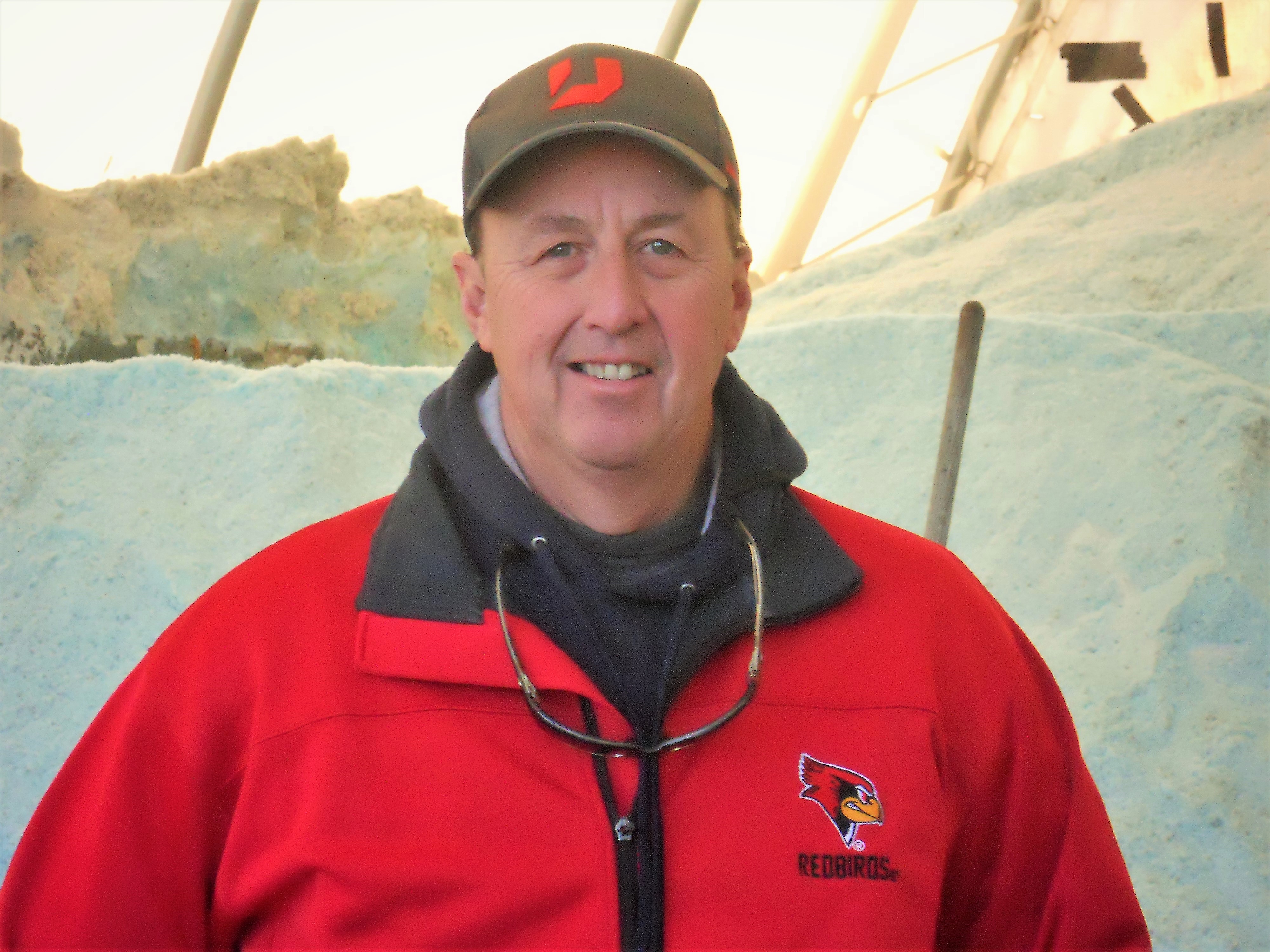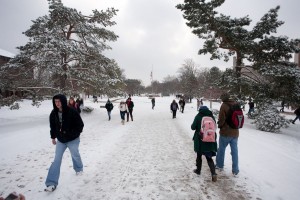On a Friday afternoon in mid-January, while many on campus were thinking about the possibility of weekend “snow days” and getting to the store to stock up on essentials, Bill Koos was glued to the forecast and deciding on the best of three or four plans and options for campus snow removal—all of which will begin at 4 a.m. the next morning. Koos has served Illinois State University as a grounds foreman for over two years now, and recently sat down to talk about snow removal, teamwork, global landscape design, and recruitment and retention.
With recent snow and record cold weather closing campus, it was interesting to hear how a ‘typical winter day’ is different in the world of grounds keeping. “Snow and weather dictate our days any time during the week and frequently multiple times throughout a day,” said Koos. “Freezing, thawing, and refreezing tell us whether we will need to send the whole crew out to a location, divide and conquer, and how we will manage shifts.” Grounds runs up to three salt trucks, four utility vehicles, 12 tractors, and even snow blowers and old-fashioned shovels divided among the 20-30 crew members who might be called in to plow and salt. The day starts at least the day prior with an emergency call system to the crew, scheduling employees for what time to report to work.
“We are a sidewalk campus here at ISU, which means the main focus is always going to first be the sidewalks and safe passage for students from residence halls to dining facilities, class buildings, and essential services,” said Koos. With that in mind Koos’ crew will always position someone near Hewitt/Manchester at Fell Avenue in order to clear the way to those fantastic quesadillas and bacon (availability depends on when students might wake for “breakfast”). Intersections at School Street and College Avenue and College Avenue and University Street are high priorities to open passage to classes, Bone Student Center, and Student Health Services.
Events on campus also play a part in determining priorities and plans, especially when parking lots and decks come into play. Decisions have to be made about how much snow there will be, the ability to plow around vehicles on decks and get drive-lanes open, and the ability to manage a schedule to remove same day or the next. Unique to snow removal of the parking decks (to watch from a distance, of course) is that after snow is plowed into a specific place on a deck, and after salting, the next day that snow may need to be removed by lifting and dropping over the wall of the deck to the ground below.
According to Koos, planning for snow removal begins even before a building is constructed. “One of the first things we do when we see the plans for new construction is begin to dialogue and plan for where the snow will go, options for removing ice, and how that will work within or add to our current strategies,” he said.
Associate Vice President for Facilities Management Planning and Operations Chuck Scott said Koos is always thinking ahead. “It is so nice to have someone like Bill on staff. He is always thinking several months in advance, even now he is planning for the sowing of the seeds and flower beds, despite our current cold spell.”
Koos brings a unique eye to Illinois State University in his work, having been able to assess landscape projects in a variety of locations. “I served in the Navy for six years, spending time as an independent photographer and living in the Azores off the coast of Portugal for 32 months,” said Koos. “There I flew with the Spanish, the Israelis, the Dutch; and I was able to see how other designers treated the architecture. Some use intimate style close to the buildings, whereas others preferred a simplistic approach—two to three trees only changing the looks of buildings.” In addition to that worldly view, Koos also lives the University value of civic engagement from the strategic plan, currently sitting as the mayor of Minonk.
As the weather changes to spring (think warm thoughts as you read this, please), Koos’ crew will shift even more toward other seasonal activities. This means landscaping plans for the west side of the Bone Student Center revitalization project, retaining walls, mowing, weeding, tree trimming, and even leaf removal and debris removal.
Koos was glad that leftover leaves might not be a huge issue this year. One of his favorite moments from last year was during one of the “shortest windows” (as he calls them) that Mother Nature opened up for work. In the fall, the leaves fell across the Quad in such a short time, and between other weather events, that the entire crew took to the Quad in one very long day and removed foliage that can usually take a few smaller crews several days over several weeks. “It was important to use that window before snow fall, or else those leaves sit, trap moisture, and invite disease to the campus’ centerpiece.”
Koos believes the work of Grounds is all part of that vital first impression. “Some families only get one opportunity to visit before making a college decision,” said Koos. “Making our campus a beautiful place to be and enjoy impacts the recruitment experience and can help with retention. When we maintain campus, as well as when we plan new landscaping projects, we focus on practicality, beautification, and of course safety” He mentioned that campus staff are already planning some great things for spring, summer, and fall planting that will do exactly that—make the campus aesthetically pleasing, while keeping it passable, enjoyable, and safe.”
For more information on Grounds, Facilities, the Master Plan and other efforts, visit Facilities Services online at https://facilities.illinoisstate.edu/.



